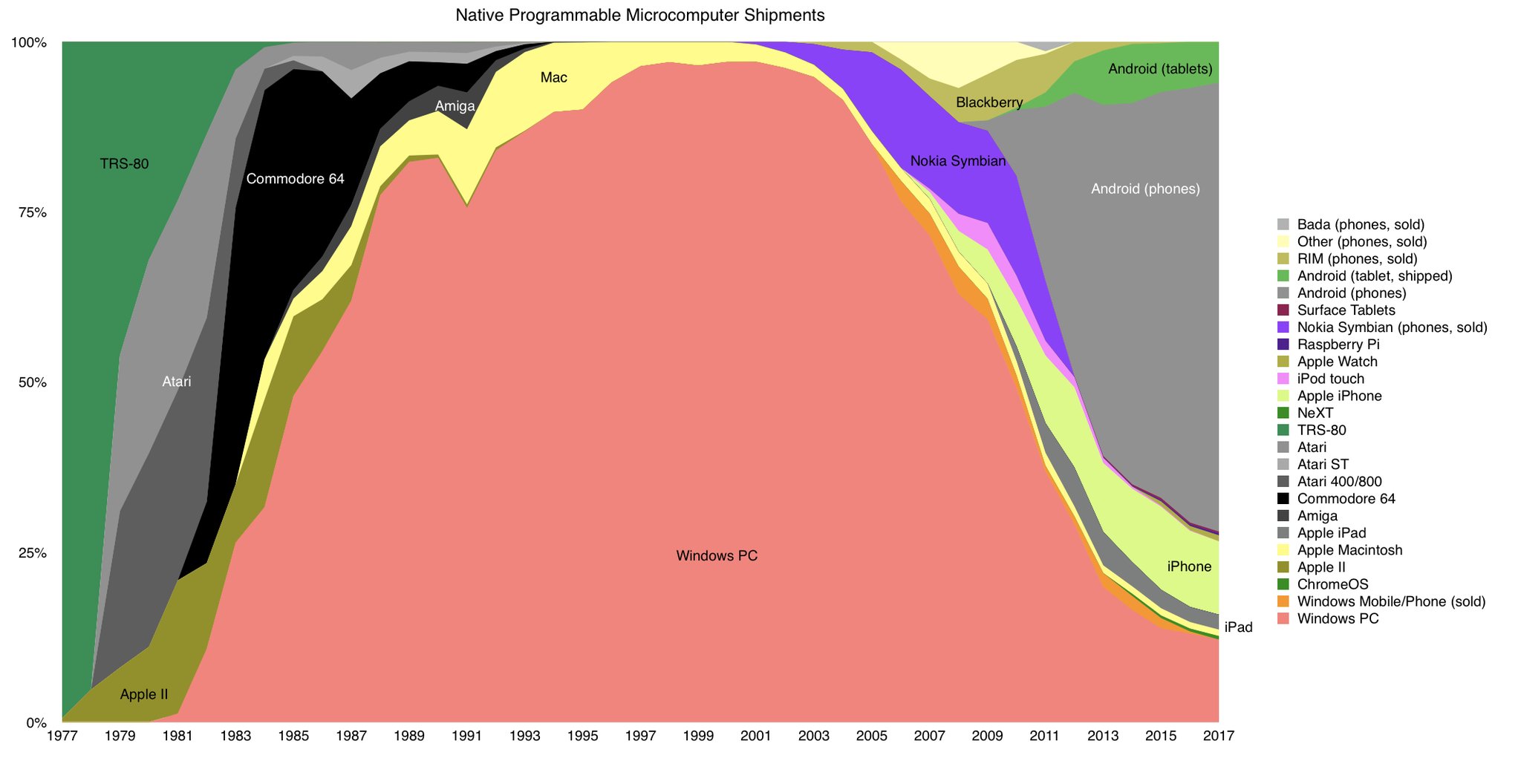This morning I ran across the following graph via Horace Dediu.

I developed Windows software during the fattest part of the Windows curve. That was a great time to be in the Windows ecosystem.
Before that I was in an academic bubble. My world consisted primarily of Macs and various flavors of Unix. I had no idea that my world was a tiny minority. I had a PC at home, but mostly used it as a terminal to connect to remote Unix machines, and didn’t realize that Windows was so dominant.
When I found out I’d been very wrong in my perception of market share, I determined not to be naive again. Ever since then I regularly look around to keep an eye on the landscape.
The graph above combines desktop and mobile computers, and you may or may not think that’s appropriate. Relative to the desktop market, Windows remains dominant, but the desktop market share itself has shrunk, not so much in absolute size but relative to total computer market.
Last time I looked, about 70% of the traffic to this website comes from desktops. I still consider the desktop the place for “real work,” and many people feel the same way.
It’s conventional to say the Roman Empire fell in 476 AD, but this would have been a surprise to those living in the eastern half of the empire who considered themselves to be Roman. The eastern (Byzantine) empire continued for another thousand years after the western empire fell.
The Windows empire hasn’t fallen, but has changed. Microsoft is doing well, as far as I know. I don’t keep up with Microsoft as much as I used to. I have no animosity toward Microsoft, but I’m no longer doing the kind of work their tools are intended for. I still use Windows—I’m writing this blog post from my Windows 10 machine—though I also use Mac, Linux, iOS, and Android.

This is also “sold by year”.
Phones last much less than even laptops (they break, the battery decays…), so the steady state is that, in the last few years, I have purchased two computers (1 desktop + 1 laptop, both running Linux) and 6 android devices (3 phones + 2 tablets + 1 e-book).
However, I still spend more time on the computer than on all of the other devices combined.
The most interesting part of this graphic is how misleading it is and how a so-called statistician, and self-styled technologist, (you) fell for it. Windows still massively dominates desktops and laptops. Windows isn’t being replaced. New technologies, i.e., tablets and phones, have emerged. Now fools are pretending tablets and phones are replacing desktops and laptops, when in reality, they are complementing desktops and laptops.
Ken, did you read the post?
Am I missing something? That graph doesn’t mention Linux at all. The data is described as “Native Programmable Microprocessor Shipments” – I’m not sure what that means but does it group “PC shipped with Windows which later had Linux installed on it” along with “Windows PC”?
I’m not clear how the data should be interpreted in terms of the OS (or maybe better described as “computing platform”) that people are using.
Paul, I don’t know anything about where the data in the chart came from. It’s possible that Linux computers are being counted as Windows PCs. It’s also possible that the number of Linux desktops that were not sold as Windows desktops is so small that it wouldn’t be visible in the chart if it were included.
Let’s estimate what this chart would look like in absolute numbers, not percentages. The TRS-80 Model I sold 200k units total, so say 50k units in its first year. And make the left part of the graph one inch tall. 1.5b smartphones were sold in 2017, and that makes up 78% of the right end of the graph. So the right end of the graph would be over half a mile tall!
If I squint just right, I *think* I can see the UNIX/BSD/Linux line. It’s less than half a pixel wide, but I swear it’s there.
It’s peculiar not to see MS-DOS in the graph at all; it surely dominated the market once upon a time.